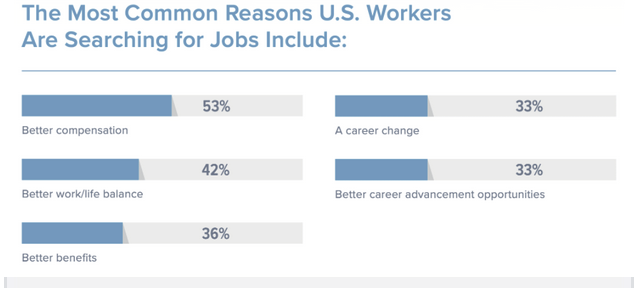
Why 2022 has New Baselines for Attracting and Retaining Talent

With the clock ticking down the hours until the end of 2021, it is not a stretch to assume that companies and decision makers are not only being proactive about the people they want to hire but also identifying ways to hold on to the talent they have. The last 18 months have been a rollercoaster for the global job market, especially for those business sectors that have been impacted by the pandemic-enforced nature of remote and hybrid workforces.
And while no industry has been immune to the changes in how we work, it can be argued that the goalposts have certainly been moved this year.
This shift has had a profound effect on what employers are looking for and, importantly, what employees want. CNBC recently reported that more than 50 percent of Americans plan to look for new jobs in the early months of 2022 – a state-of-play that the news source coined as “the Great Resignation” – and the fact that so many people are willing to make a change in the U.S. alone is likely being mirrored in other parts of the globe.
For those of us in the tech sector, unemployment rates have been historically low for some time – Dice Insights cited figures from the U.S. Bureau of Labor Statistics that suggested a rate of 2.6 percent in November, for example. Demand for talent has always been high in tech-related businesses, but there is little doubt that the number of people available is significantly lower than the hundreds of thousands of open positions. Unsurprisingly, this makes effective recruitment planning and retention strategies just that tiny bit harder.
The key is to understand what people are looking for, and this stems from a series of new baselines for employee expectations.
Job Seekers Would Like “Flexibility”
One of the biggest questions we get asked by potential employees is how flexible our workplace is. This enquiry is actually very common in today’s post-pandemic work environment, with Indeed’s 2021 Hiring Trends Report noting 71 percent of surveyed employers said they offer more flexibility to employees than they did before the public health crisis.
In the new normal, flexibility actually relates to where work will be done – remote work, for example, is arguably now part of the mainstream, while the requirement for people to be in the office has diminished. The latter is of particular interest for hiring processes, especially as there is no longer a set formula for what works (no pun intended) and what doesn’t – a recent Forbes article, by way of example, said that there is a defined need for companies to build the “everywhere workplace.”
What people really want to know in terms of flexibility is whether or not they will be allowed to work remotely or required to be in (or within a commutable distance of) the more traditional office environment. Indeed’s report, for instance, said that 85 percent of employers were OK with workers working remotely for an indefinite period, with 49 percent of respondents offering more remote options than they were prepared to do in the recent past.
The caveat to all this flexibility is that in-person office work can be hugely beneficial in terms of the water-cooler moments that can lead to both innovation and cross-team collaboration. In addition, the in-office experience is not something that you can replicate at home, irrespective of how easy it can be to work in sweats and a graphic tee.
For job seekers, they also want confirmation that the company they are joining will allow them to choose both the workplace environment and the location in which they want to work … in other words, they would prefer that the definition of flexibility gives them the option to mix and match as required. Again, this is not taking the office out of the equation entirely, more that there is an acknowledgment that there may be times when that option is needed.
In my experience, many folks who are new to the workforce want to have the ability to go into the office for either part of or the full work week.
These employees value in-person connections, shared lunches and happy hours more than the mid-career professionals who have already been there and done that. For those reasons alone, the right candidates will be the ones whose preferred workplace options align with what you can offer.
Compensation Matters. Sometimes.
A widespread push for higher compensation is also becoming a baseline factor. According to a recent SHRM survey, 58 percent of employers report that they are offering higher starting salaries and wages than in 2020, in addition to “beyond normal” yearly increases for current staff.
Professional satisfaction in the work that one does is always a key part of the equation. And while compensation may be the reason somebody starts their job search, it’s unlikely it will ultimately be the factor that decides what their next job will be.
I have found that financial remuneration tends to be an overrated factor in the recruitment process, but it is not rocket science to know that you should be offering competitive compensation. As you can see from the graphic below, slightly more than half of all U.S. workers are looking for more money to switch jobs, with other factors (work/life balance, benefits etc.) also coming into play.
You should also never underestimate the value of workplace or company culture and while this can be hard to define – in the new normal, at least – the organizations that can prove low staff churn, DEI (diversity, equity, inclusion), and effective communication from leadership will be attractive to many job seekers.

Source: SHRM, October 2021 Survey
In my 15 years in the talent acquisition community, I have recognized that benefits are as important to many job seekers as salary. Simply put, these elements ensure a certain quality of life for the employee and their family.
With that in mind, I know that benefits are a big part of recruitment conversations, and I don’t expect that will change as we progress through 2022.
Have Real Conversations with Candidates
It’s critical in today’s market for recruiting teams to have real conversations with candidates that get to the bottom of what each individual is looking for. This may seem obvious, but if you can either offer them what they want or identify the fact that your organization is a bad match early doors then you put both parties in the right position.
Working at a high-growth company like ours where life is good and work is fast, I need to know whether a candidate is looking for opportunities to grow in the near term or if they just want a job to hold at the level of expertise they’ve attained so far. The latter requirement may not be the right fit for our company and – unless you have a real conversation – you may not suss that out until the individual has accepted the terms offered and received the welcome pack.
This may sound like the old baseline – having a directed conversation isn’t novel – but today’s hiring market is hotter than ever and candidates know this. In fact, it’s imperative that recruiters still take the time to confirm whether a candidate’s goals align with the objectives of the team they might join.
Without wishing to bring the pandemic up again, the landscape has changed for hiring companies and the candidates that are available. Indeed’s Hiring Trends report said that 94 percent of employers are happy to hire talent outside of local markets and 77 percent are more than willing to consider remote workers. With these doors open, the candidate pool for every job listed is (in theory) larger than it’s ever been.
In response, organizations and recruiters need to make time to have real conversations. And in a competitive market, candidates can afford to wait to find the right opportunity.
Find People Who Align with Your Company
In the talent acquisition community, there is a lot of chatter about attrition.
As we hit the end of 2021, it is becoming a very real pain point. As the market continues to be competitive, there is an argument that if you (as an individual) have a high-demand skill set, you can walk away from your job with confidence that another will be waiting for you.
So, as you recruit new talent, you need to make sure that your company can deliver on the priorities of each candidate and that the minuses – the less-than-ideal aspects of your organization from that candidate’s vantage point – are things they can live with.
The latter may seem to be counter-intuitive from a hiring standpoint, but not everything in the workplace is rainbows and unicorns. Candidates will likely know that, which means that having a frank conversation about priorities and making sure you’re in alignment on both the pluses and the minuses is key to reducing attrition. It’s also just the right thing to do.
Redefine Culture Fit
When people talk about culture fit, even in presidential elections, they ask if they can imagine themselves getting a beer with a candidate – and that’s where likeability and unconscious bias comes in.
What that question really is: How much like me is this person?
In a hybrid or remote environment, it’s important to start thinking differently and talking differently about “cultural fit.” A better approach is to ask two questions:
- Do our goals line up from a project standpoint?
- Do our goals line up in the long-term?
From there, you can more clearly evaluate whether a candidate is the right fit for the role you’re hiring for and you can use these questions to prompt a candidate to check in with themselves on both the project level and the career level.
For companies and business leaders to attract and retain top talent, they need to think of the process as a one-to-one marketing campaign. That is the first step, albeit that you need to be aware that the baseline for both employer and employee (current and potential) is often driven by market trends and overall expectations.
That puts the onus on not only recruiting the right person at the right time for the right job but also understanding that the way we work has changed significantly. The tech industry is fast-paced and constantly evolving, attracting and retaining the people that want to be part of your vision for the future are the ones that will provide the value and energy required for future success.
Are you looking for your next career move? Do you want to join a team that thrives on collaboration and problem-solving? Do you want to solve the biggest digital challenges of our times? To find out if our company is right for you, take a look at our careers page and apply today.